By Mike Smith
Almost every season my team encounters an opponent which we feel we are better than as far as “soccer skill” goes, yet we always seem to struggle and the games always get “ugly”. Even though these teams lack in soccer, they excel in competition: they get numbers to the ball, they mark and challenge well, they never lose their depth, they keep their enthusiasm for frustrating their opponents, they are in great condition, etc…..
When faced with an opponent like this, I take comfort in the fact most soccer fields are simply too big for a side to cover every inch of and I try and use this to my teams advantage by playing a wide diamond. The diagram below shows the concept , with the left and right mids and back line providing cover for the long wide passes. ( Don’t worry about the guys in yellow eager to get in, I’m gonna get them in on the next slide ).
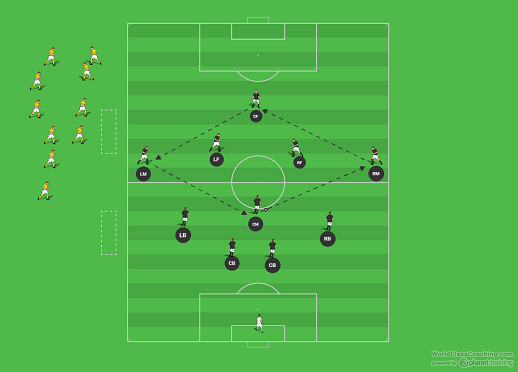
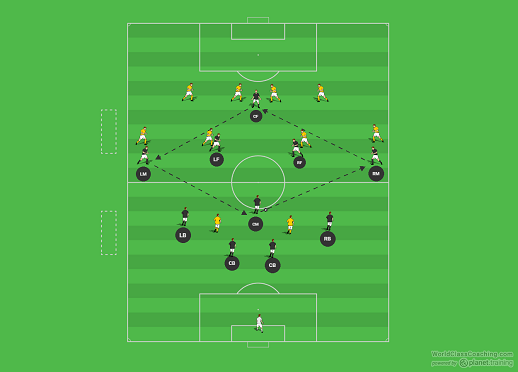
The diagram above shows how the wide diamond works against a 4-4-2. This concept will yield far more possession than a wide open attacking style ( which usually plays right into the hands of solid, physical well conditioned teams) but will keep the game under control and hopefully create more attacking space to exploit as the game draws on.
The idea is based on the commonly used thirds of the field – left, center, right and attacking, transition, defensive. The diamond moves the ball constantly between all thirds. The center ( holding ) mid, center forward and left and right mids ( wings ) are the targets. Should any of the covering players get the ball under pressure, they should seek to find one of the target players in the wide diamond. However ( below ) as the game goes on, creative passes and runs out of the diamond by supporting players will lead to opportunities.
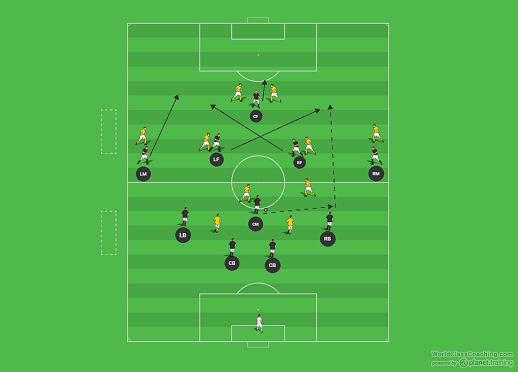
This is also a great system for teams who do not have a lot of depth at every position, or are lacking experience / skill at a few positions. A solid center mid, strong central forward and two fast wings can control a game using this concept, even against an aggressive opponent. Soccer is a game of space. If you have space, you have time. Giving less skilled or experienced players more time to work is the first step in those players becoming more skilled. By putting the ball in the hands of your best players most of the time, in a way which creates a ton of space for the opponent to cover, the stage is set for every member of your team to play to their strengths. This also makes a great adjustment from a more compact style as well. If you think the wide diamond may help your team, try this at practice:
Set Up
Set up a 30 x 30 grid as shown. Each section represents a third of the field. 4 attacking players work outside the grid, one per each side to make the diamond. Inside the grid, two additional attacking players work against 4 defenders. All players must stay in their designated areas ( inside players stay in, outside players stay out ).This set up simulates a 4 v 6 which can easily be created during a match by using the wide diamond shape. Play starts with an outside player passing to any other attacking player, with a goal of passing to players in different thirds of the field.
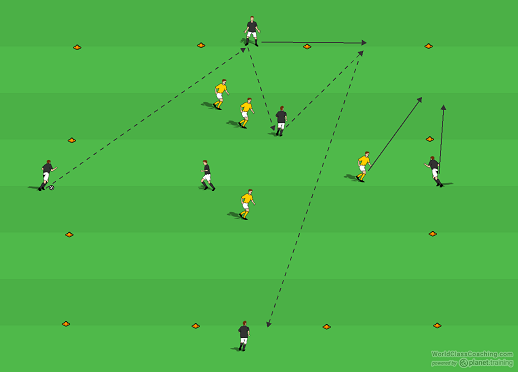
The diagram above shows the potential movement of the players and the ball, with the following diagram ( below ) showing the next options based on the initial series of passes. As the diagram shows, there should be numerous options to move the ball to open players in different thirds. Attacking players inside the box should work quickly to get the ball back out and not force play into a 4 v 2 disadvantage. Should the defending team get the ball, they should possess it until they make a set number of passes ( 8 – 12 ) and then restart play with the attacking team. IF the attacking team can make 8 – 12 passes this counts as a “point” and play is restarted. Eventually all the players can switch roles but this is a good drill for the players to work in their common positions ( 4 defenders inside the box vs two central mids with a holding mid, forward and two wings working on the outside ).
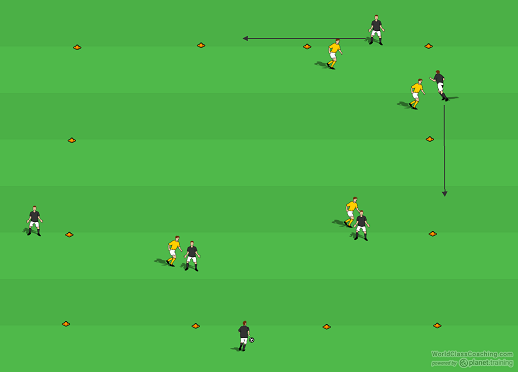
Coaching Points
The wide diamond is basically a “clash of styles” type of formation. IF the opposition can win the ball they will have numbers up in the central areas of the field – but that is a big IF. The coach should encourage the attacking team to keep the ball moving and keep it spread out between the thirds; after all, the idea is to simply make the field too big for the defending team to cover. A good full field scrimmage with one side using the wide diamond ( essentially a 4-5-1 ) is a great progression after this initial warm up drill.
By Mike Smith
Currently the Head Coach for University Heights Academy Boys Soccer in Hopkinsville, KY , Mike is in his 14th year as a high school head coach with 23 years coaching experience overall and 34 year as a student and fan of the game. He holds a USSF D License.


